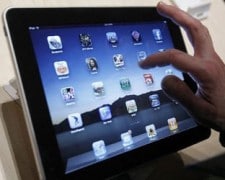 One of the wonders of the new millennium for those of us who grew up with electronic devices attached by a cord to a wall socket is the newfound ability to watch high quality video from just about any location. But it turns out that doing so at the moment costs a lot, both in terms of spectrum and cash.
One of the wonders of the new millennium for those of us who grew up with electronic devices attached by a cord to a wall socket is the newfound ability to watch high quality video from just about any location. But it turns out that doing so at the moment costs a lot, both in terms of spectrum and cash.
Stories in both the Wall Street Journal and the Washington Post took looks at the iPad. It is being presented as the device of choice to take advantage of the mobile video revolution. It features high definition screen said to outperform most television sets, and it accepts high speed data transmission via the 4G model.
However, people who actually try to use it that way are finding it to be impractical. One user cited by WSJ burned through an entire month’s bandwidth allotment by streaming one March Madness NCAA basketball game.
The WaPo article echoes that anecdote, noting that a single two-hour movie could wipe out a user’s monthly bandwidth account.
The technology was thought to be another alternative to a costly cable or satellite TV subscription, but that is proving not to be the case. The WSJ example involved a basketball fan who paid $30 for 2gb of service. After burning through that as quickly as he did, he was looking at another $10/gb to add more access to his account.
On the delivery side, providers are also still looking for ways to manage bandwidth, including curbing use by its biggest fans.
RBR-TVBR observation: We are still in the early stages of the mobile video revolution. In just a few years, we’ll probably wonder how today’s technical wizards could have missed solutions to by-then-solved bandwidth challenges, just as today we marvel at the brutal techniques and unsanitary conditions utilized by Civil War surgeons.
We understand why legislators and regulators feel the need to get the incentive auctions going – the lead time consumes years, and it’s necessary to start taking steps at some point.
We aren’t scientists, but we expect other things to be happening while the auctions are being set up:
1) mobile broadband transmission and reception will become more efficient;
2) telecoms will find ways to make effective use of other spectrum in bands; and
3) broadcasters will develop ways to translate their one-to-many transmission model to help accommodate the demand for mobile video content.
While the bureaucrats are doing their thing, we would very much like to see scientists and innovators do theirs as well, and ultimately diminish the need for bureaucratic intervention.





